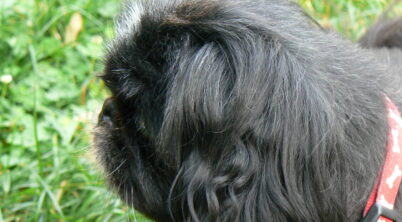If you have a breed with big, expressive eyes and a face that’s pretty flat, chances are, that dog is a Pekingese. These little guys have shallow eye sockets and short noses, which means their eyes can be easily injured or become diseased. If you have a breed with a snout that sticks out further from the face, it doesn’t matter how big those eyes are — they’re probably pretty well-protected from run-ins with tree branches or couches. Not so with the Pekingese.
Veterinarians frequently treat Pekingese for corneal ulcers, which are often the result of scratches to their eyes. Such injuries can occur readily in these dogs because their eyes protrude and are not well-protected. In severe cases, these ailments can lead to more serious complications, including the loss of an eye.
Care for Pekingese should include regular checks to ensure their eyes are free from scratches, irritation, and the onset of infection. Owners need to be vigilant and seek professional veterinary attention when eye problems are suspected. Swift treatment with appropriate medication like antibiotics or anti-inflammatory drugs can prevent complications and enhance the quality of life for these dogs.
Table of Contents
Understanding Pekingese Eye Anatomy and Common Conditions
The breed’s flat face and large, protruding eyes are the primary physical characteristics that make them more likely to suffer eye problems, of which they have more than any other breed.
Brachycephalic Head Shape
Pekingese dogs have a brachycephalic head shape, characterized by a greatly shortened upper jaw and nose, leading to decreased depth of the orbits, the bony eye sockets. Having such a configuration can make the Pekingese’s already prominent, large eyes seem even more so and can present them with eye-related challenges that include injuries and diseases.
Unique Eye Concerns in Pekingese
Pekingese dogs have short heads, so their eyes might get dry and cause irritation. Dry eye is characterized by a reduced tear production, leading to eyes becoming dry and irritated. They can also get corneal ulcers, also known as eye sores, they hurt and are on the eye surface. These can happen because of damage to their bulging eyes.
Common Ocular Diseases in Pekingese
Eye conditions that are often seen in the Pekingese:
- Entropion: A genetic condition in which a portion of the eyelid is inverted or folded inward, causing the eyelashes to rub against the cornea.
- Cherry eye: This condition involves the prolapse of the third eyelid gland, leading to a visible red mass in the corner of the eye.
- Progressive Retinal Atrophy (PRA) – An eye disorder that makes eyes worse, finally leads to not being able to see.
- Cataracts: Pekingese can inherit this condition, where the lens of the eye becomes cloudy, obstructing vision.
Identifying Symptoms and Recognizing Eye Emergencies
When it comes to Pekingese eye health, early recognition of symptoms can prevent the progression of conditions that may lead to vision loss. Understanding the signs and knowing when to seek veterinary help are critical steps in protecting your dog’s eyesight.
Signs of Eye Problems
Pekingese are prone to eye issues, so owners should be vigilant for common symptoms indicating a problem. Look for:
- Discomfort: Pekingese often paw at their eyes or appear restless if experiencing eye pain.
- Red Eyes: Redness can signify inflammation or irritation.
- Discharge from the Eyes: Any unusual discharge could indicate an infection or blockage.
- Squinting: If a Pekingese’s eyes hurt or can’t see well, they might squint. It’s a way of trying to see better or reduce pain.
- Sensitivity to Light: If your Pekingese seems to avoid bright areas, it might be due to eye discomfort.
Immediate Veterinary Attention
Certain signs warrant immediate veterinary consultation to prevent serious damage or blindness:
- Acute Pain and Redness: These might suggest conditions such as acute angle closure glaucoma, a pressing emergency.
- Sudden Loss of Vision: Quick action is essential if your Pekingese suddenly bumps into objects or has trouble navigating familiar environments.
- Pronounced Discharge: Especially if it changes in color, consistency, or is accompanied by a foul smell.
A preventive veterinary checkup at least once a year is recommended for brachycephalic breeds like Pekingese to address health issues early on, including those affecting the eyes.
Practical Care and Preventative Measures
Taking good care of a Pekingese’s eyes needs regular attention to keep them healthy and prevent any sight problems. Daily grooming and protecting them from accidents are important ways to do this.
Daily Attention and Cleaning
Regular cleaning is an essential step to prevent infections in the Pekingese’s eyes. Due to their shallow eye sockets and prominent eyes, they are prone to accumulate discharge. Owners should gently clean around the eyes with a warm wet cloth daily.
- Grooming: Keeping the fur around the eyes trimmed will prevent irritation caused by the dog’s own hair.
- Cleaning Routine:
- Use a soft, wet washcloth or cotton pad.
- Carefully wipe the area around the eye to remove discharge and debris.
- Avoid touching the eye’s surface to prevent scratches.
Protecting Against Injuries and Trauma
Pekingese dogs have big eyes and a short face, so they can easily hurt their eyes. Here’s how to keep them safe:
- Make a safe play area without sharp stuff.
- Watch out when they are with other pets or small kids.
- Go to the vet regularly to check their eyes.
Doing these things all the time will keep Pekingese dogs from getting hurt and losing their sight.
Treatment Options for Pekingese Eye Issues
When helping Pekingese dogs with their eye problems, it’s important to use different methods like medicine, surgery, and care at home to keep their condition in check and stop them from losing an eye.
Medical Interventions
Medical intervention is the first line of treatment for many Pekingese eye problems. Medicine may be given for bacteria to stop problems like eye pain. For dry eyes, experts suggest ointments with drugs to make tears and fake tears to keep eyes wet. For bacteria, doctors give antibiotics to avoid harm.
Doctors give antibiotics if their eyes are sick from bacteria, like keratitis. For issues like Dry Eye, vets say use ophthalmic ointments to make tears and artificial tears to keep eyes wet. Meds to make tears are: Cyclosporine and Tacrolimus. eye drops: to kill bacteria help too.
Surgical Procedures
Surgery helps with bad cases like prolapse of the third eyelid or the Pekingese’s face shape means big eye problems.
These procedures are typically performed by veterinary ophthalmologists and are tailored to the specific issue at hand.
Home Care and Management
Regular home care is crucial for managing Pekingese eye conditions and includes regularly cleaning the area around the eyes to prevent infection. A sterile saline solution can be used to flush out any irritants, and wiping with a soft, damp cloth helps to remove discharge and debris. Owners should also watch for any changes in their dog’s eye health and consult their veterinarian if problems persist or worsen.
- Daily Eye Care Routine:
- Flush eyes with sterile saline solution to remove debris
- Gently wipe the surrounding areas with a moistened cloth or cotton pad
- Apply any prescribed ointments or medications as directed by the veterinarian
Expert Advice: When to See a Vet
Pekingese owners should be vigilant about their pets’ eye health due to their predisposition to various eye conditions. Regular checkups with a veterinarian play a crucial role in preventing and managing ocular issues.
Signs that warrant immediate veterinary attention:
- Excessive tearing or discharge: Could indicate an infection or blockage.
- Redness or inflammation: could mean your dog has allergies or irritation.
- Squinting or frequent blinking: May signal pain or discomfort, possibly due to inflammation or complications from inherent breed characteristics.
- Visible foreign objects: Any debris should be removed by a professional to prevent scratches or infections.
A routine veterinary visit is advised if:
- The Pekingese is rubbing its eyes excessively, suggesting discomfort or irritation.
- There’s a noticed change in appearance, such as cloudiness or change in eye color, indicating possible serious eye health issues.
Preventative care includes:
- Regular cleaning of the area around the eyes to prevent bacterial buildup.
- Keeping the hair around their eyes trimmed to avoid irritation.
Owners should not underestimate the severity of eye conditions, as they can lead to vision loss if untreated. Seeking a veterinarian’s expertise at the earliest signs of trouble is paramount for a Pekingese’s eye health. Being proactive and ensuring consistent veterinary care is the best defense against serious eye conditions in this breed.








